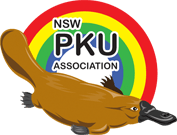Update: August 2012
It has been a spectacular few months of fundraising by a small dedicated group of parents and friends, and a special vote of thanks must go to Mirella Nicomede for spearheading a team who staged a wonderful gala dinner, which raised $140, 00 on behalf of the PKU Association of NSW. On top of that, the unflappable Maureen & Terry Pankhurst initiates the fundraising challenge raising another $50,000 all of which has been tagged to support PKU Research. We are humbled that so many friends should work so tirelessly on our behalf, and of course the PKU research team at the Children's Hospital at Westmead is spurred on by this faith in us to push our research activites to new levels.
The major focus of our research at present is the further development and validation of our genetically modifed probiotic to treat PKU. Our genetically engineered Lactococcus probiotic bug makes good amounts of the enzyme, phenylalanine ammonia-lyase (PAL), and we have previously shown that in the test tube we get good clearance of phenylalanine using this GM probiotic.
More recently, our Rotary PhD scholar, Naz Al-Hafid, has been testing the robustness of our GM probiotic, which was done by carrying out a series of experiments simulating the environment of the stomach and small intestine, and has shown, at least in the test tube, that our GM probiotic can survive these harsh conditions for the relative short duration of our testing time. Most exciting though was her first experiments in the PKU mouse, where she showed when she feeds them our GM probiotic and labeled phenylalanine, we see a marked reduction in the amount of phenylalanine being absorbed into the mouse's bloodstream. There are many questions though:
1. Will the GM probiotic break down the phenylalanine 'locked' in dietary protein in the gut? Our test tube experiments suggest yes, but we need to do these experiments in the mouse too.
2. Do we need to give the GM probiotic every time the mouse feeds? If not, how many times a day will we need to give the GM probiotic?
3. How long will the GM probiotic survive in the mouse gut?
4. How much GM probiotic will we need to give and how effective will it be in 'real life'?
All of these experiments are planned and will be carried out over the next 12 months.
At the same time, Dr XingZhang Tong, a postdoctural research scientist in our laboratory, who has been working on producing the GM probiotic for about four years now, is working on making an even better version, which will we hope will be even more resistant to the harsh conditions of the small intestine, and which will enhance the functional capacity of the PAL enzyme. He is also planning to explore whether Lactobacillus rather than Lactococcus may be a better way of delivering PAL to the gut.
Naz had an opportunity to present her research at the recent Human Genetics Society of Australasia (HGSA) conference held in Canberra in July, which generated considerable interest indeed from those involved in the management of children and adults with PKU. In fact, she won a prize for her work. Well done Naz!
We're also very pleased to report that Gladys Ho, who has been involved in a number of PKU research project with is over the last four years, will very shortly be submitting her PhD thesis for examination. She too presented her research at the HGSA conference, which was also very well received.
